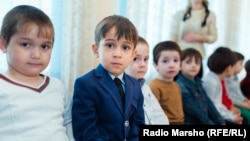For the past 10-15 years, Chechnya has boasted one of the highest birth rates in Russia, and one of the lowest mortality rates, resulting in steady population growth (1.8 percent in 2015) considerably higher than that of the country as a whole.
Consequently, according to official statistics, Chechnya’s population has grown from 1.205 million on January 1, 2008 (a figure some analysts consider implausible) to 1.269 million at the time of the October 2010 Russia-wide census and 1.391 million in November 2015.
At least half that population is under 30 years of age.
At the same time, the number of children born in Chechnya rose from 25,800 in 2004 to a record 36,532 in 2009. Since then, however, the number of births has declined, to 34,770 in 2012 and 29,498 in 2015. And, during the first six months of 2016, the birth rate fell by a further 6.9 percent, the steepest decline of any region in Russia.
True, the infant mortality rate too has reportedly fallen, from 24.9 per 1,000 live births in 2012 to 15.4 in 2014 and 11.8 in 2015, but that decline does not balance out the decrease in the number of births.
A number of factors may have contributed, separately or in combination, to the falling birth rate.
Couples who started a family in the 2000s and thus contributed to the rising birth rate between 2004 and 2009 may by now have three or more children and have decided not to have any more -- whether for financial reasons or because they do not consider the current atmosphere in Chechnya, which critics of regional leader Ramzan Kadyrov say is permeated by fear and repression, conducive to bringing up a family.
It may or may not be a coincidence that the birth rate peaked in 2009, two years after Kadyrov was first appointed president and granted carte blanche to remold Chechen society by imposing a blend of quasi-Islamic ideology and brute force.
In addition, antipathy towards Kadyrov and his henchmen has impelled tens of thousands of Chechens to leave Russia in recent years. Human rights activist Svetlana Gannushkina described in 2013 how entire streets would decide collectively to sell their homes, rent a bus, and head for the West. Only a very few formally notify the authorities of their intention to leave the country, hence a growing discrepancy between the officially registered number of inhabitants and the number of people who actually live in Chechnya.
In 2013, the Chechen government formally denied German media reports that up to 10,000 Chechens had submitted asylum requests.
Between January and mid-May 2016, coinciding with the recent steep fall in the birth rate, some 2,244 Chechens applied for political asylum in Germany alone, according to the German Interior Ministry.





